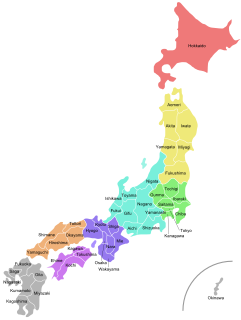
Japan is divided into 47 prefectures, forming the country's first level of jurisdiction and administrative division. They include 43 prefectures proper, two urban prefectures, one "circuit" or "territory" and one "metropolis". In 1868, the Meiji Fuhanken sanchisei administration created the first prefectures to replace the urban and rural administrators in the parts of the country previously controlled directly by the shogunate and a few territories of rebels/shogunate loyalists who had not submitted to the new government such as Aizu/Wakamatsu. In 1871, all remaining feudal domains (han) were also transformed into prefectures, so that prefectures subdivided the whole country. In several waves of territorial consolidation, today's 47 prefectures were formed by the turn of the century. In many instances, these are contiguous with the ancient ritsuryō provinces of Japan.

The national flag of Japan is a rectangular white banner bearing a crimson-red circle at its center. This flag is officially called Nisshōki, but is more commonly known in Japan as Hinomaru. It embodies the country's sobriquet: Land of the Rising Sun.

"Kimigayo" is the national anthem of Japan. The lyrics of "Kimigayo" are the oldest among the world's national anthems, and with a length of 32 characters, they are also the world's shortest. The lyrics are from a waka poem written by an unnamed author in the Heian period (794–1185), and the current melody was chosen in 1880, replacing an unpopular melody composed by John William Fenton eleven years earlier. Its length of 11 measures is currently among the world's shortest. While the title "Kimigayo" is usually translated as "His Imperial Majesty's Reign", no official translation of the title or lyrics has been established in law.

The Kansai dialect is a group of Japanese dialects in the Kansai region of Japan. In Japanese, Kansai-ben is the common name and it is called Kinki dialect in technical terms. The dialects of Kyoto and Osaka, especially in the Edo period, are also called Kamigata dialect. The Kansai dialect is typified by the speech of Osaka, the major city of Kansai, which is referred to specifically as Osaka-ben. It is characterized as being both more melodic and harsher by speakers of the standard language.

Tottori Prefecture is a prefecture of Japan located in the Chūgoku region of Honshu. Tottori Prefecture is the least populous prefecture of Japan at 570,569 (2016) and has a geographic area of 3,507 km2. Tottori Prefecture borders Shimane Prefecture to the west, Hiroshima Prefecture to the southwest, Okayama Prefecture to the south, and Hyōgo Prefecture to the east.
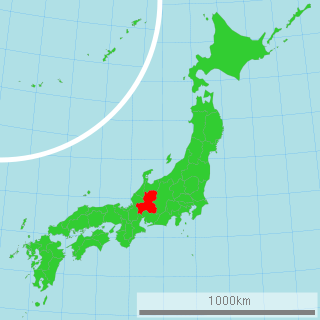
Gifu Prefecture is a prefecture of Japan located in the Chūbu region of Honshu. Gifu Prefecture has a population of 1,991,390 and has a geographic area of 10,621 square kilometres (4,101 sq mi). Gifu Prefecture borders Toyama Prefecture to the north; Ishikawa Prefecture to the northwest; Fukui Prefecture to the west; Shiga Prefecture to the southwest; Mie Prefecture and Aichi Prefecture to the south; and Nagano Prefecture to the east.

The Kanto region is a geographical area of Honshu, the largest island of Japan. In a common definition, the region includes the Greater Tokyo Area and encompasses seven prefectures: Gunma, Tochigi, Ibaraki, Saitama, Tokyo, Chiba and Kanagawa. Within its boundaries, slightly more than 45 percent of the land area is the Kanto Plain. The rest consists of the hills and mountains that form the land borders. According to the official census on October 1, 2010, by the Japan Statistics Bureau, the population was 42,607,376, amounting to approximately one third of the total population of Japan.
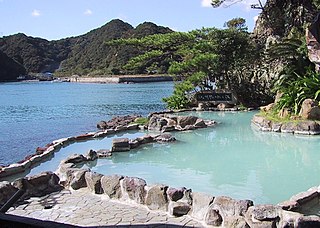
In Japan, onsen (温泉) are the country's hot springs and the bathing facilities and traditional inns around them. As a volcanically active country, Japan has thousands of onsens scattered throughout all of its major islands.

Tokyo Bay is a bay located in the southern Kantō region of Japan, and spans the coasts of Tokyo, Kanagawa Prefecture, and Chiba Prefecture. Tokyo Bay is connected to the Pacific Ocean by the Uraga Channel. Its old name was Edo Bay. The Tokyo Bay region is both the most populous and largest industrialized area in Japan.
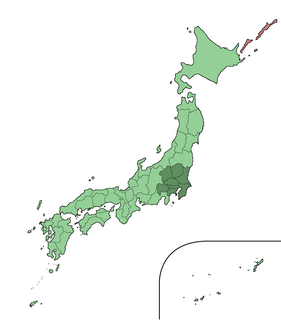
The Greater Tokyo Area is the most populous metropolitan area in the world, consisting of the Kantō region of Japan as well as the prefecture of Yamanashi of the neighboring Chūbu region. In Japanese, it is referred to by various terms, one of the most common being Capital Region.

The Olympic symbols are icons, flags and symbols used by the International Olympic Committee (IOC) to elevate the Olympic Games. Some—such as the flame, fanfare and theme—are more commonly used during Olympic competition, but others, such as the flags, can be seen throughout the years. The Olympic flag was created under the guidance of Baron de Coubertin in 1913 and was released in 1914. It was first hoisted in 1920 in Antwerp, Belgium at the 1920 Summer Olympics in the main stadium. The five rings represent the five continents of the world.

Bōsōzoku is a Japanese youth subculture associated with customized motorcycles. The first appearance of these types of biker gangs was in the 1950s. Popularity climbed throughout the 1980s and 1990s, peaking at an estimated 42,510 members in 1982. Their numbers dropped dramatically in the 2000s with a reported number of under 7,297 members in 2012.

The Act on National Flag and Anthem, abbreviated as 国旗国歌法, is a law that formally established Japan's national flag and anthem. Before its ratification on August 13, 1999, there was no official flag or anthem for Japan. The nisshōki (日章旗) flag, commonly referred to as the hinomaru (日の丸), had represented Japan unofficially since 1870; "Kimigayo" (君が代) had been used as Japan's de facto anthem since 1880.
The Saitama Railway Line is a mostly underground rapid transit line in Japan operated by the third sector operating company Saitama Railway Corporation. Funded by Saitama Prefecture, local municipal governments, and Tokyo Metro, it forms a continuation of the Tokyo Metro Namboku Line, starting at Akabane-iwabuchi Station in Tokyo and ending at Urawa-Misono Station in Saitama. The line is used as the main means of transportation to Saitama Stadium 2002. On 27 November 2015, the route was nicknamed the "Saitama Stadium Line". The line symbol used in the station numbering is "SR".
The Rising Sun Flag symbolizes the sun as the Japanese national flag does. This design has been widely used in Japan for a long time. The design of the Rising Sun Flag is seen in numerous scenes in daily life of Japan, such as in fishermen's banners hoisted to signify large catch of fish, flags to celebrate childbirth, and in flags for seasonal festivities.
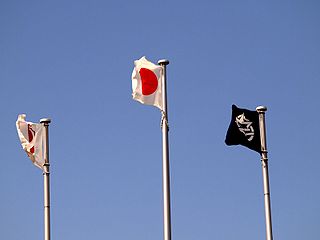
The list of Japanese municipal flags lists the flags of municipalities of Japan. Most municipalities of Japan have unique flags. Like prefectural flags, most of them are with a bicolor geometric highly stylized symbol (mon), often incorporating characters from Japanese writing system.
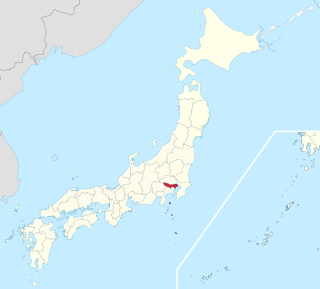
Tokyo Metropolis has two official emblems. One is called the crest (monshō) and the other is called the symbol. It also has the two official flags, featuring either emblem.
Events in the year 1958 in Japan. It corresponds to Shōwa 33 (昭和33年) in the Japanese calendar.





























































